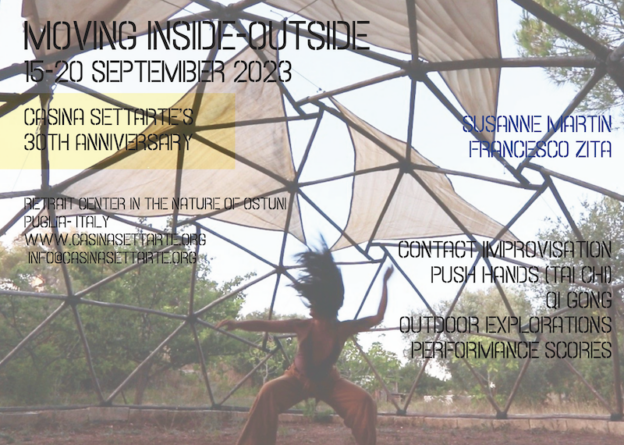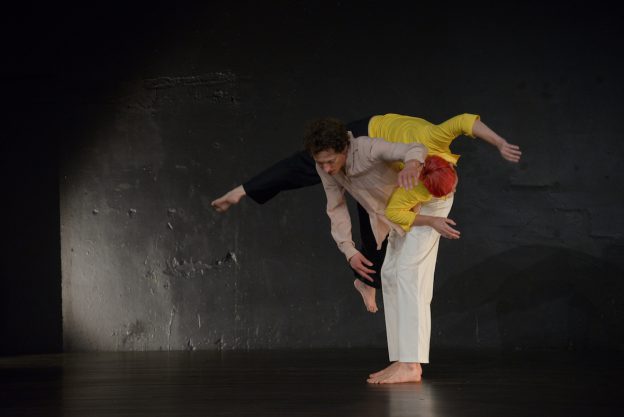– Thur 28 December 2023, 19:00, “Tympanum“. – Fr 29 December 2023, 19:00, “Les choses comme elles sont“. – Sat 30 December 2023, 19:00, “E X I (S) T“. Location: Studio Zwischenraum, Mauerrain 5, 3012, Bern With Peter Aerni, Giacomo Calabrese,Simon Halbedo, Chantal Langlotz, Susanne Martin
Author:neuername
next performances
Was ist Improvisation? Eine Lecture Performance von Susanne Martin 20 April 2024 Salt & Pepper, Festival for Improvisation, Basel, Schwitzerland, more info here Dancing Age(ing), Lecture Performance by Susanne Martin 8 May 2024 Inter-University Centre for Dance Berlin, HZTmore info soon
workshops spring/summer 2024
12 – 14 April 2024 in BernImprovisation as Art: Making Happen / Letting Happen (for people with some experience in dance impro or CI, teaching language is German or English)How and when do I intervene, initiate change, set accents within an improvisation? How and when do I let things happen, go with the flow, get… Continue reading workshops spring/summer 2024
workshops oct-dec 2023
10-15 August 2023 Jam Sweet/Sour – CI intensive at international Contact Improvisation Festival Freiburg Fr 13 – Son 15 Oktober 2023 in Bern Tanzimprovisation: Eigen-Sinn und Ensemble Dance Improvisation: Idiosyncrasy and Ensemble Fr 15 – Son 17 Dez 2023 in BernContact Improvisation: Fallen und Berühren üben Practising falling and touchingfür Menschen mit CI- oder Tanzimpro-Vorerfahrungfor people with… Continue reading workshops oct-dec 2023
lecture performances improvisation for scientists
27 October 2020 Improvisation für die Universität? Gewohnheiten in Bewegung Lecture Performance, Saalfrei Festival Stuttgart 21 January 2020 Improvising to Collaborate – Collaborating to Improvise research presentation with Martin Sonderkamp during the annual research week at the University of the Arts Stockholm June 2019 Bodies in the Making interactive danced lecture with generous participation of … Continue reading lecture performances improvisation for scientists
publications
Martin, S. (forthcoming 2024) Performing Bodies / Performing Relationships. In: Tau, R., Kloetzer, L., Henein, S. (eds.) Barefoot Academic Teaching: Performing Arts as Pedagogical Tool in Higher Education. Edition Scenario. Berlin: Schibri. Bauer, L.; Boos, P.; Martin, S.; Nöthen, E.; Reuter, G. (2023) Er-Fahrung – Cycling Spaces im Salon Raumverstehen: Mobilitätspraktiken im Quartier geographisch-künstlerisch beforschen.… Continue reading publications
some moving images..
bodies in the making – research impro & engineering learning to improvise… research impro & engineering dancing with real bodies – research impro & engineering ASCOPET research trailer Videos for publication „Performing Bodies / Performing Relationships“ The Fountain of Age – trailer – research dance age The Fountain of Youth – trailer – research dance… Continue reading some moving images..
Newest Article: Embodying Recognition
Dance Improvisation for Scientists My new artistic research article /exposition is in the Research Catalogue (2023) OPEN ACCESS – GO HERE From the perspective of a dance artist and artistic researcher, I trace the details of how and why I created events for scientists to encounter dance improvisation through shared exploration and shared reflection. Interlacing… Continue reading Newest Article: Embodying Recognition
Book reviews of Dancing Age(ing)
Meticulous and rich, the book incorporates theoretical density with practice-based insights. […] Martin’s work supports the wider acceptance of Practice as Research (PaR) in academic settings as a rigorous and comprehensive mode of critical inquiry and knowledge production. Michelle Heffner Hayes in Critical Studies in Improvisation 12 (1) Martin has keen insights into the gaps… Continue reading Book reviews of Dancing Age(ing)
Dancing Age(ing) lecture performances 2019 – 2023
24 May 2023 Jung bleiben und Sterben üben – eine Lecture Performance zu Alter(n) und Tanz, Ringvorlesung, Zentrum für interdisziplinäre Alterns- und Care-Forschung, Karl Franzen Universität Graz 4 December 2022 Üben, Üben, Üben NachWieVor – Fachtag Tanzperformance und Alter(n), Ehrenfeld Studios Köln, Germany 30 January 2020 Dancing Age(ing): an Ongoing Practice and a Danced Lecture… Continue reading Dancing Age(ing) lecture performances 2019 – 2023
Residential Workshop Italy 15 – 20 Sept 2023 Susanne & Francesco
MOVING INSIDE OUTSIDE Contact Improvisation – Push Hands (Tai Chi) – Qi Gong – Partnering – Outdoor Explorations – Performance Scores Intensive dance workshop with Susanne Martin and Francesco Zita at Casina Settarte, Puglia Italy, 15 – 20 September 2023 Susanne’s teaching is based in contact improvisation, instant composition and 30 years of creating performances… Continue reading Residential Workshop Italy 15 – 20 Sept 2023 Susanne & Francesco
Improvisation Workshops Spring 2023
Teaching language German/English, translation into French possible (with a little help from my friends).
Improvisation Workshops Autumn 2022
Basel 4-6 Nov 22, level: advanced/professional Bern 18-20 Nov 22, level: with CI experience
Was ist Tanz? Seniorenakademie SKAT, April 2022
Centre Français BerlinMit Susanne Martin und Jan Burkhardt Durch eine Mischung von Vortrag, Workshop und Performance widmen wir uns einigen zentralen Tanzthemen wie zum Beispiel: Wonach gucken wir, wenn wir Tanz sehen?Woran denken wir, wenn wir selbst tanzen?Wie verhält sich Tanz zu Ton und zu Musik?Was könnte man wissen und was will ich wissen über… Continue reading Was ist Tanz? Seniorenakademie SKAT, April 2022
Salon Raumverstehen 2021 mit Gabriele Reuter
http://kimkommt.de/arbeiten-mit-kim/vergangene-veranstaltungen/
Performing Improvisation with L’Âme de Fonds 2021
Au beau milieu / Au bas mot, 29/30 Dec 2021, Neuchatel, Switzerland with Peter Aerni, Giacomo Calabrese, Simon Halbedo,, Chantal Langlotz, Simone Marty, Susanne Martin
Article: Dancing with Real Bodies
Dancing with Real Bodies: Dance Improvisation for Engineering, Science, and Architecture Students is published in “Algorithmic and Aesthetic Literacy 2021 OPEN ACCESS HERE How can dance improvisation contribute to learning processes within a technical university? This article proposes an answer to this question from the perspective of an artistic researcher and dancer who specializes in… Continue reading Article: Dancing with Real Bodies
Three Cornered Circle 2020
Trio Improvisation, Saalfrei Festival Stuttgart 23.10.2020Maya Carroll (Tanz), Susanne Martin (Tanz), Kurt Holzkämper (Musik)
Understanding Dance for Beginners and Intermediates, May 2020
This video tutorial (4 episodes) is a response to the statement “I don’t understand dance” – a sentence we encounter ever so often when moving away from the inner circles of dance lovers and dance experts. So, we attend to questions like: What do I look for when watching dance? What’s the relationship between dance,… Continue reading Understanding Dance for Beginners and Intermediates, May 2020
Stromen 2019
Duet improvisation with Simon Wenger (Basel)26 November 2019 Stromen & group improvisation with the Frenesi Trio, FIM Basel, Switzerland29 November 2019 Stromen with participation of Kurt Holzkämper & group improvisation with Instant PIG // Stuttgart, SAAL FREI Stuttgart, Germany
Learning. Teaching. Dancing. 2018
Learning. Teaching. Dancing.for “Remembering the Future – 40 years of Tanzfabrik Berlin”A “Doc Martin Dance Lecture“ with Susanne Martin (in English language)all Photos: AnnA Stein Learning. Teaching. Dancing. is an interactive dance lecture for beginners, professionals, and the generally curious. Within the frame of “Remembering the Future – 40 years of Tanzfabrik Berlin” this dance… Continue reading Learning. Teaching. Dancing. 2018
RETROPERSPEKTIVE 2017
Duet with Felix Marchand6 December 2017, SODA Festival, HZT Berlin Retroperspective It is ten years by now that Felix and Susanne became SODA-pilot-students at the Inter-University Centre for Dance Berlin (HZT). Ten years during which they didn’t find the time to go into the studio together. Now it finally happened. Come and celebrate with them… Continue reading RETROPERSPEKTIVE 2017
Artistic Research Project: Improvisation for Scientists
A postdoctoral research project at Ecole Polytechnique Fédérale de Lausanne (EPFL), Switzerland, hosted by Instant-Lab, Prof. Simon Henein. My artistic research is part of the interdisciplinary research project ASCOPET (Les arts de la scène comme outil pédagogique dans l’enseignement tertiaire), a collaboration between Prof. Simon Henein, EPFL and Prof. Laure Kloetzer, University of Neuchatel (Unine).… Continue reading Artistic Research Project: Improvisation for Scientists
Performing Improvisation – VARIA Festival Sweden 2018
19/20 October 2018 at Konstepidemin Göteborg Participating artists:Susanne Martin choreographer, dancer (DE)Irena Z. Tomažin voice artist, dancer (SI)Alessio Castellacci composer, voice artist (IT/DE)Alex Nowitz composer, voice artist (DE)Hui-Chun Lin musician, composer-artist (TW/DE)Lisa Larsdotter Petersson performance and visual -artist (S)Video-light installation & video documentation – Christina Hallström filmmaker, visual artist (NL/S) Moderator conversation – Jannine Rivel… Continue reading Performing Improvisation – VARIA Festival Sweden 2018
Performing Improvisation with L’Âme de Fonds 2017
28 – 30 December 2017 at L’Arsenic Lausanne, Switzerland with Giacomo Calabrese, Simon Henein, Chantal Langlotz, Lukas Langlotz, Susanne Martin, Alexandra Mcdonald, and morePhotos: Giacoma Calabrese, Simon Henein















